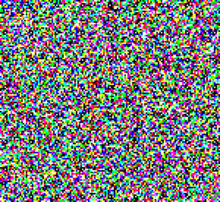JAB code
The JAB code ( J ust A nother B ar Code) is a further development of the two-dimensional barcodes or QR codes , which uses colored pixels in particular to achieve a higher data density.
background
The JAB code is a 2D code that has a higher data density than the black and white codes. This barcode was developed by the Fraunhofer Institute for Secure Information Technology (SIT) in Darmstadt as a contract development for the Federal Office for Information Security (BSI). The use of the codes is intended to increase the security against forgery of documents that do not contain electronics, such as birth certificates and other official certificates. The additional security arises from the fact that the digital signature of the content is also printed as a JAB code on the document. The code can be applied to the documents with commercially available printers and checked with any smartphone. In addition, unlike "normal" QR codes, it is not restricted to rectangular or square shapes. The codes can be generated and read out on a website.
A next goal is to implement the JAB process with gray levels so that it can be used in industry together with monochrome cameras.
standardization
The JAB code is currently being standardized by the International Organization for Standardization (ISO). The responsible committee is ISO / IEC JTC 1 / SC31 / WG 1, whereby the JAB code is listed there with the identifier NP23634.
An official open source implementation of the process is available, licensed under the LGPL v2.1.
The code is on the BSI document BSI TR-03137 Optically Verifiable Cryptographic Protection of non-electronic documents (Digital Seal) Part 2 defines
technology
Basically it is a normal 2D barcode, but the individual fields are not black and white. At the moment, when using 8 colors with conventional smartphones, three times the information density can be achieved. This can be increased significantly with the use of higher quality cameras.
There are 2 types of JAB codes, called primary and secondary symbols. A JAB code always consists of a primary and any number of (also 0) secondary symbols. In a primary symbol there is a pattern in each corner that defines a clear assignment and orientation. These patterns differentiate between the primary and secondary symbols; these patterns do not exist for the secondary symbols. Secondary symbols can be attached horizontally and vertically at any position to a primary symbol without any spacing. The strength of the error correction can be selected by the creator.
Web links
- Fraunhofer Sit website with scan and generation of JAB codes
- Data Protection Information Project JAB code
- BSI TR-03137 Optically Verifiable Cryptographic Protection of non-electronic Documents (Digital Seal)
- BSI TR-03137 BSI TR 03137 - Part 2: JAB Code (Just Another Bar Code). Color Bar Code Symbology Specification
- JAB Software (Github)
- Colorful barcode replaces package insert. In: n-tv. November 27, 2018, accessed March 15, 2020 .
- New barcode with high data density for greater protection against forgery. (No longer available online.) In: all-about-security.de. Formerly in the original ; accessed on November 28, 2018 . ( Page no longer available , search in web archives )
Individual evidence
- ↑ JAB Code: Colorful barcode against counterfeiting. November 28, 2018, accessed May 23, 2019 .
- ↑ JAB code. Retrieved November 29, 2018 .
- ↑ Proof of authenticity on colorful barcode. November 26, 2018, accessed May 23, 2019 .
- ↑ jabcode / jabcode. Retrieved November 29, 2018 .
- ↑ BSI TR-03137 Optically Verifiable Cryptographic Protection of non-electronic Documents (Digital Seal) .
- ↑ Barcodes become colorful - and can then do a lot more. December 4, 2018, accessed June 2, 2019 .
- ↑ GitHub: JAB code. Retrieved June 2, 2019 .


